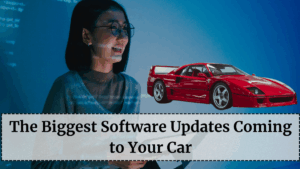In 2025, cars are no longer just machines — they’re intelligent, connected computers on wheels. From performance improvements to new entertainment features, car software updates in 2025 are transforming how vehicles operate and evolve over time. With Over-the-Air (OTA) updates, automakers can now upgrade vehicles remotely, bringing advanced safety, comfort, and connectivity without a trip to the service center.
Let’s explore the biggest software updates coming to your car in 2025, how they work, and why they’re redefining the driving experience.

How Software Updates Are Changing Modern Cars
From Hardware to Software-Defined Vehicles
Traditional cars depended heavily on mechanical upgrades, but 2025 marks the rise of Software-Defined Vehicles (SDVs). In these cars, most features — from driving modes to entertainment — are managed through software that can be updated anytime. This shift makes vehicles more adaptable, future-ready, and customizable.
The Power of OTA (Over-the-Air) Updates
Over-the-Air (OTA) technology allows automakers to deliver software patches, feature enhancements, and bug fixes directly through the internet. No physical visit, no downtime — your car simply updates itself. Brands like Tesla, Mercedes, and Hyundai already use OTA to push monthly improvements, while more manufacturers are joining in 2025.
Top Software Updates You’ll See in 2025
1. Enhanced Autopilot and Driver Assistance
AI-powered updates will refine Advanced Driver Assistance Systems (ADAS), making cars smarter at recognizing traffic signs, pedestrians, and lane patterns. These improvements reduce accidents and make long drives safer and smoother.
2. Real-Time Performance Optimization
Performance-based software updates can tweak power delivery, suspension, and throttle response without any hardware changes. Tesla and BMW are offering paid updates to unlock better acceleration or new driving modes instantly.
3. Intelligent Battery and Range Management
For electric vehicles, 2025 updates will focus on battery optimization — improving range prediction and charging speed. Companies like Hyundai and BYD are introducing software that adapts battery usage based on weather, terrain, and driver behavior.
4. Personalized In-Car Experience
Your car will soon understand you better than ever. New software platforms allow deep personalization — seat adjustments, lighting color, and even air-conditioning can be tailored automatically through driver profiles and facial recognition.
5. Next-Gen Infotainment and App Integration
The in-car infotainment system is evolving into a smart ecosystem. With Android Automotive OS and Apple CarPlay 2.0, vehicles in 2025 will support app downloads, voice assistants, streaming, and even gaming. OTA updates will keep your system as fresh as your smartphone.
6. Cybersecurity and Data Protection
As cars become more connected, cybersecurity updates are critical. Automakers are releasing regular security patches to prevent hacking and protect user data. In 2025, real-time threat detection AI will become standard in most high-end vehicles.
7. Subscription-Based Feature Activation
More car companies are moving to the “features-on-demand” model. Through software, owners can subscribe to additional features like heated seats, parking assist, or premium audio whenever they choose — just like streaming services.
The Benefits of Regular Software Updates
Modern car updates ensure that vehicles become better with time instead of depreciating. Owners gain:
-
Improved safety and reliability through constant updates.
-
Higher resale value, since features and performance improve post-purchase.
-
Reduced maintenance as predictive software detects problems before they occur.
-
Personalized user experience that adapts to your habits and preferences.
How Automakers Are Competing in 2025
Car companies are now racing to build their own digital ecosystems:
-
Tesla remains the leader in OTA updates, pushing weekly upgrades.
-
Mercedes-Benz is developing “MB.OS,” a proprietary platform for smart connectivity.
-
Hyundai, Kia, and Tata Motors are introducing affordable OTA-enabled cars to capture emerging markets.
-
BMW and Volvo are focusing on AI-based vehicle learning for smarter personalization.
These changes mean owning a car in 2025 will feel like owning a smartphone — one that improves every few months.
The Future of Connected Cars
By 2026, every major automaker aims to offer fully software-driven cars capable of self-learning and seamless connectivity with smart homes and city infrastructure. The combination of AI, 5G, and OTA technology will make vehicles more intelligent, efficient, and secure than ever before.
In short, the car of 2025 won’t just take you places — it will evolve, learn, and upgrade along the journey.
FAQs
What are OTA updates in cars?
OTA (Over-the-Air) updates allow manufacturers to send new software, bug fixes, and performance improvements directly to your car via the internet.
Do all new cars support software updates?
Not all, but by 2025, most mid-range and premium cars will support OTA technology for updates and new feature rollouts.
Can a software update improve car performance?
Yes. Updates can refine throttle response, battery efficiency, or acceleration, giving better performance without mechanical modification.
Is it safe to install car updates at home?
Absolutely. OTA updates are designed to install safely while parked or overnight, just like a smartphone update.
Will car updates require a subscription?
Some brands are offering optional paid updates for premium features, but critical updates like safety patches remain free.
Click here to know more.
